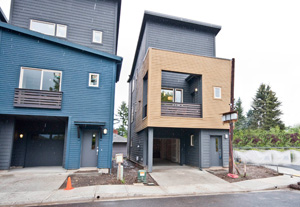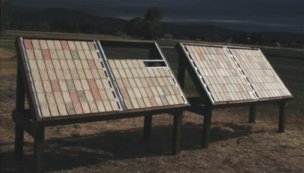The end of 2009 marked the completion of the fourth year of operations for the Oregon Wood Innovation Center. We continue to emphasize connections to assist Oregon wood products firms solve challenges and pursue new opportunities. We work to connect industry personnel with our resources and technical information, help connect buyers and sellers of Oregon forest products, and enable industry professionals to network with one another.
At the same time, we also set our sights on longer-term opportunities that will benefit the State’s forest cluster as a whole. In 2009, we participated in a multi-agency effort to develop an economic development strategy for the State’s forest cluster. One outcome of this effort was the inclusion of a forest cluster initiative in the Oregon Innovation Council’s 2009 Innovation Plan.
Below are highlights of our activities and accomplishments in 2009, and brief details on where we are headed in the years ahead.
2009 Impacts
Websites - we continue to emphasize web-based tools such as the Oregon Forest Industry Directory (OFID) as a way to help connect buyers and sellers of Oregon forest products and services. OFID became a far more comprehensive directory for Oregon's forest cluster this year - we worked with the Institute for Culture & Ecology to add dozens of non-timber forest products to the directory and merged the former Oregon Woodlands Assistance Catalog to add over 350 forestry service providers. 'Hits' to OFID doubled between 2008 and 2009 (from 2.5 million to over 5 million). One landowner stated that he's had so much success selling logs through his listing that "I'm ready to quit my day job."
Newsletters - 9 issues of our newsletter were developed covering timely topics like the results of research exploring the quality-innovation connection, potential impacts of the Lacey Act, and a new publication on communicating the green advantages of wood to customers.
Courses/Workshops - the downturn in the economy resulted in greatly scaled-back course offerings in 2009; we only offered two of our regular series of courses (How to Dry Lumber for Quality & Profit and the Northeast Utility Pole Conference) and one new course on the Lacey Act.
Contract projects - nearly 60 contract projects were conducted on things like strength testing of utility pole crossarms and shear walls, wood identification, analysis of veneer checking on hardwood plywood, inspection and remedial treatment of wood in-service at historical sites (Fort Vancouver), assessing migration of wood preservatives in-service, etc. Impacts of some of these projects include:
- Screw withdrawal testing for ceiling panels - assisted Eugene-based 9Wood by measuring screw pullout strength in particleboard core ceiling panels. As a result, 9Wood has created an industry leading quality control system.
 Seismic testing of a new shear wall design - plywood-on-foam wood frame shear walls were tested for Green One Construction in Portland to ensure code compliance. The walls are highly energy efficient due to an additional layer of foam between the sheathing and framing. Testing resulted in the panels being approved by building code officials and in fact, have already been used in a new, hybrid zero-net-energy green building development project in Washington County, OR.
Seismic testing of a new shear wall design - plywood-on-foam wood frame shear walls were tested for Green One Construction in Portland to ensure code compliance. The walls are highly energy efficient due to an additional layer of foam between the sheathing and framing. Testing resulted in the panels being approved by building code officials and in fact, have already been used in a new, hybrid zero-net-energy green building development project in Washington County, OR.- Durability testing of western juniper (pdf) - we have been assessing the durability of juniper fence posts since the late 1920s. In 2009, this work was supplemented with research on termite resistance of juniper. The combined results led to juniper's listing in the Oregon building codes as a ‘naturally durable’ species. The expected impact of this is increased market opportunities for juniper manufacturers as the species has overcome one regulatory hurdle.
- Mechanical properties of second growth hemlock - provided a company a report by compiling existing research data; as a result, company personnel stated, "My efforts to put together a contract were greatly enhanced through the report you provided... [it] absolutely made a difference in our customer's decision to purchase USA produced Lumber." The estimated value of this contract is $200,000 per month.
 Research on coatings for wood decks - we have been working in a cooperative project with Viance LLC to test the efficacy of wood coatings that seek to minimize checking and discoloration on wood decking materials. Materials are being exposed to precipitation and UV light at OSU's Klamath Basin Research & Extension Center. This cooperative project is targeted at proving concepts and methodologies that can be used in new product development for this important area of wood protection.
Research on coatings for wood decks - we have been working in a cooperative project with Viance LLC to test the efficacy of wood coatings that seek to minimize checking and discoloration on wood decking materials. Materials are being exposed to precipitation and UV light at OSU's Klamath Basin Research & Extension Center. This cooperative project is targeted at proving concepts and methodologies that can be used in new product development for this important area of wood protection.- Technical assistance for checking on hardwood plywood - we assisted a composite panel manufacturer whose product was being used as core material for hardwood plywood. According to the firm, our report, "...showed that the very thin veneer coupled with drastic changes in humidity between the laminations and finishing location and the job site resulted in veneer checking. The report ...allowed [the company] to avoid a very large claim."
Work In Progress
We will continue to focus on both short-term problem-solving technical assistance as well as longer-term efforts to assist Oregon firms remain competitive in the global marketplace. Examples of 'work in progress' include:
- Problem-solving research - we are working on several projects related to hardwood plywood - checking in maple veneer, panel warping, and veneer discoloration
- Biomass - a biomass dryer is currently being installed that will allow us to explore different approaches to dry various types of biomass fuels; also in the works are facilities to test BTU content of various forms of biomass fuel such as pellets, chips, hog fuel, etc.
- Workshops - new modules for the wood composite science distance education short course are being developed as is a distance ed version of our wood basics course.
- Underutilized species - we continue to pursue efforts to find market opportunities for western juniper as well as Oregon's native hardwoods, including assisting firms that are exploring products that may be made from tanoak killed by sudden oak death syndrome (SODS)
- Resources for innovators - the first edition in our new publication series Wood-based Entrepreneurs Toolkit is now available and the second publication on Strategic Planning is nearly complete.
- Green building - thanks to funding from the Oregon Built Environment and Sustainable Technologies research center (Oregon BEST) we are developing a Green Building Materials Laboratory on the OSU campus. This will be a shared resource facility dedicated to the development and assessment of sustainable building materials.
- Economic development strategy - our faculty continue to stay involved with the multi-agency effort to develop a long- term strategy for the state's forest cluster.
